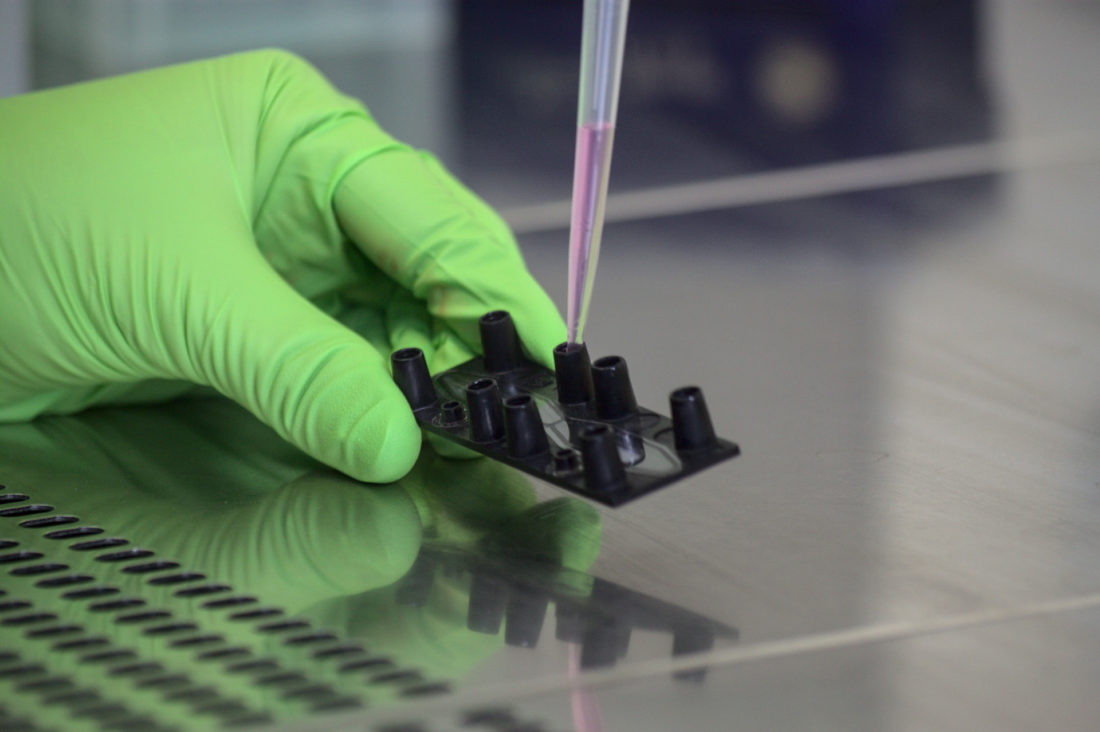Creation an Organ-on-Chip Platform: How does our technology work?
With our organ-on-chip platform, chemical and toxicological tests can be carried out on human cell cultures. In addition, it enables the investigation of mechanistic questions from basic biological research. In the future, this technology can play a major role in the testing of drugs, food additives, nanotherapeutics and other biological-chemical substances.
We give insights how our biotech chips are structured and how they work:
The microfluidic chip as a carrier of “mini-organs”
Our human, physiological cell culture systems are created in a specially developed biochip, made of biocompatible plastic, suitable for chemical and toxicological tests. The chip comprises two cavities and is designed to operate two microphysiological models in parallel, either equal types or different ones.
By integrating a porous membrane into the biochip, we achieve a spatial separation of the blood vessel and organ-specific tissues. The channels of each cavity can be operated individually, thus supporting complex 3D cell culture with unique needs. Cells can be individually introduced into the biochip and continuously supplied with nutrients and oxygen via channels and exposed to mechanical stimuli. This is of decisive importance for the tissue development and arrangement as well as the functional maintenance of the tissue over weeks.
Chemical and toxicological tests using cell culture technology
With the organ-on-chip process, possible cell changes become microscopically visible within a few hours to days after the addition of substances. In addition, like a clinical blood test on humans, data from the cell culture media can be collected during a test. At the end of a test period, the tissue can be isolated from the chip and used for further investigations, such as analysis of certain target proteins.
With our biotech chips, we can simulate the effect of various substances on the cells of the following organs:
Liver
As the central metabolic organ, the liver is of enormous importance in the development of new drugs. By integrating immune cells, for example, side effects and toxic effects of drugs can be made visible at an early stage.
Lung
With a lung model, the compatibility of substances during inhalation can be tested. For this purpose, human cells as well as essential components of the immune system are cultured on the chip. The model is also suitable for conducting infection studies with viruses, bacteria, and fungi as well as testing new therapeutics against them.
Intestine
The intestine is a very important part of the digestive tract. It serves the absorption of nutrients, the regulation of the water balance, the formation of immune cells as well as the production of hormones and messenger substances. Our intestinal model forms intestinal villi-like structures that contain tissue-resistant immune cells in addition to the characteristic cell types. This model can be used to investigate how active substances are absorbed and whether they have toxic effects on the intestinal tissue and its barrier function.
By combining the three organ models, we enable an early and relatively comprehensive detection of potential effects of various substances on the human organism. The uptake, metabolism, distribution, excretion, and toxicology of an active substance can be investigated in vitro.
We hope that our technology will contribute to increasing drug safety and eliminating animal testing, which are still standard in drug and food testing.
Picture: Dynamic42
More interesting articles:
Blog
Organ-on-chip applications by organ type – what has been done?
This blog lists examples of organ-on-chip models by organ type that have been used in the past, providing the respective literature for your reference.
Read MoreBlog
Exploring infectious disease dynamics through organ-on-chip technology
This blog explores established infection models using our organ-on-chip technology and their implications for scientific research.
Read MoreBlog
Immunocompetent Organ Models – the Future of Biomedical Research
One crucial factor that plays a pivotal role in the success of organ-on-cip models is immunocompetence. In this blog post, we delve into the significance of immunocompetence in organ-on-chip models and how it opens new avenues for advancing medical research.
Read More

